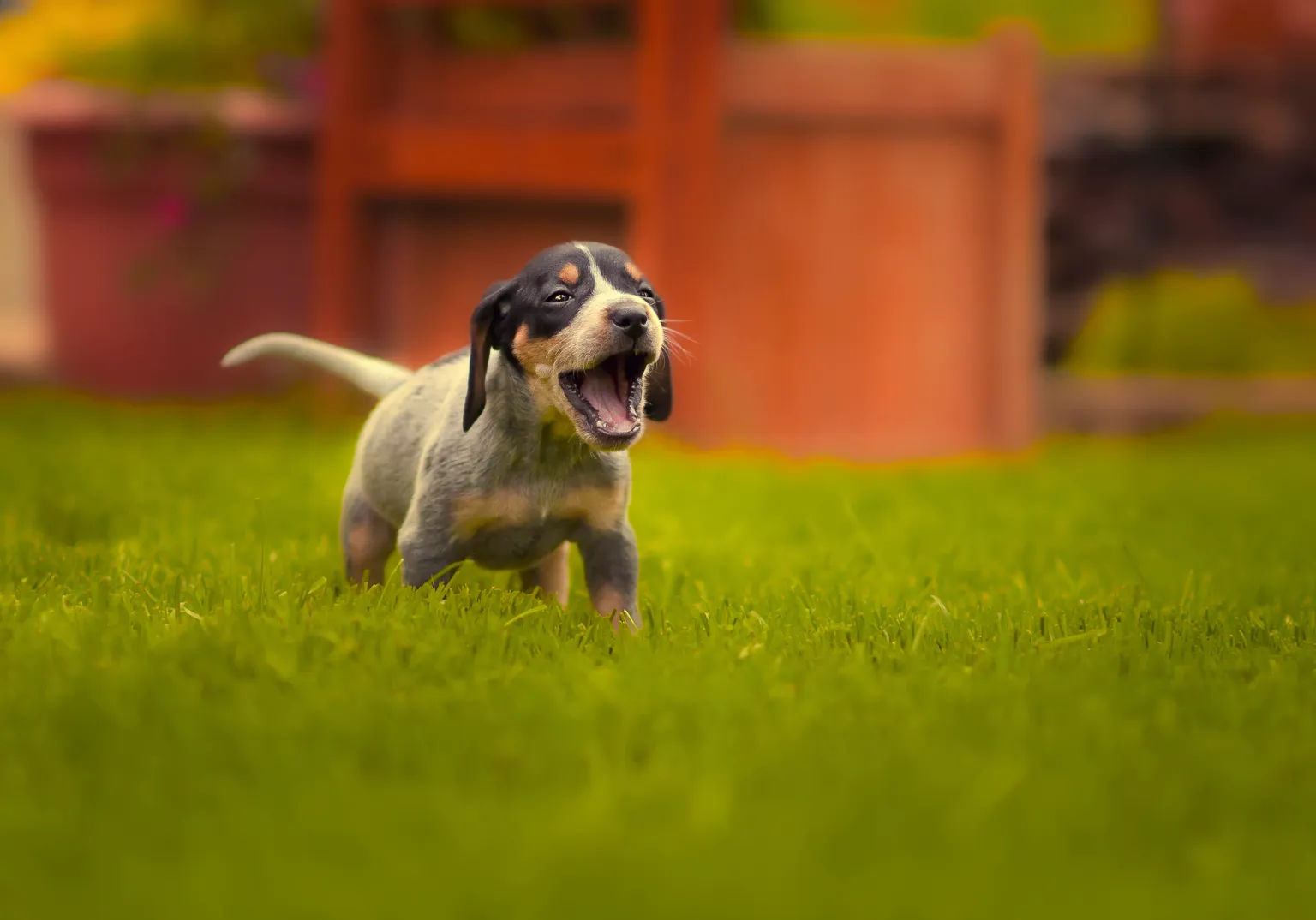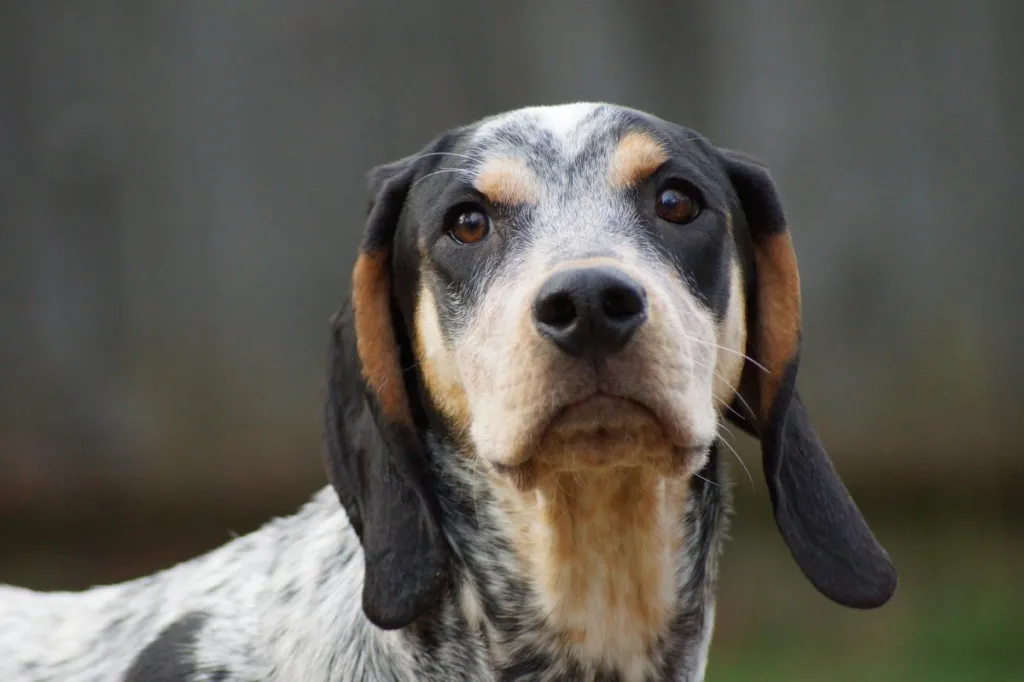Bluetick Coonhounds are remarkable dogs with a rich history and unique characteristics. Known for their distinctive appearance and exceptional hunting skills, they have won the hearts of many dog enthusiasts. Let’s dive into the fascinating world of Bluetick Coonhounds, exploring their history, physical traits, temperament, health, grooming needs, and more.
History of the Bluetick Coonhound
The Bluetick Coonhound’s origins can be traced back to the United States in the 18th century. Developed primarily in the southern states, this breed is a result of crossbreeding various hounds, including the French Bleu de Gascogne, English Foxhound, and American Foxhound. The goal was to create a dog with excellent tracking abilities, capable of trailing raccoons and other small game through rugged terrains and dense forests.
Initially bred for hunting, Bluetick Coonhounds quickly gained popularity for their unmatched scenting ability and persistence. They are named after their distinctive bluish mottled coat, which sets them apart from other coonhound breeds.
Physical Characteristics

Bluetick Coonhounds are medium to large-sized dogs with a strong, athletic build. Here are some key physical characteristics:
Size and Weight
- Males: Typically stand between 22 to 27 inches tall at the shoulder and weigh around 55 to 80 pounds.
- Females: Slightly smaller, standing 21 to 25 inches tall and weighing 45 to 65 pounds.
Coat and Color
The Bluetick Coonhound’s coat is short, dense, and glossy. The breed’s signature coat color is dark blue with a mottled or “ticked” pattern of black spots. They may also have tan markings on their muzzle, chest, and legs, adding to their distinctive appearance.
Head and Expression
Bluetick Coonhounds have a broad skull with a slightly domed shape. Their eyes are large, dark brown, and expressive, giving them an intelligent and alert expression. The ears are long, set low, and hang gracefully, enhancing their keen sense of smell.
Tail and Movement
Their tail is moderately long and carried high with a slight curve. Bluetick Coonhounds are known for their fluid, ground-covering gait, which allows them to move efficiently and tirelessly while tracking game.
Temperament and Personality
Bluetick Coonhounds are known for their friendly, outgoing, and affectionate nature. They form strong bonds with their families and are usually good with children and other pets. Here are some key traits of their temperament:
Intelligent and Independent
Bluetick Coonhounds are highly intelligent dogs with an independent streak. This independence, combined with their strong hunting instincts, can sometimes make training a challenge. Consistent, positive reinforcement training methods work best with this breed.
Energetic and Playful
These dogs are full of energy and require plenty of physical and mental stimulation. Regular exercise, playtime, and engaging activities are essential to keep them happy and healthy.
Vocal and Expressive
Bluetick Coonhounds are known for their distinctive “baying” voice, a trait inherited from their hound ancestors. They use this vocalization to communicate, especially when they catch a scent or are excited. While endearing to some, their vocal nature may not be suitable for apartment living or noise-sensitive neighbors.
Health and Lifespan
Bluetick Coonhounds are generally healthy dogs, but like all breeds, they are prone to certain health conditions. It’s essential to be aware of these potential issues and work with a reputable breeder who screens their breeding stock for common health problems.
Common Health Issues
- Hip Dysplasia: A genetic condition where the hip joint doesn’t fit correctly into the hip socket, leading to arthritis and pain. Regular vet check-ups and maintaining a healthy weight can help manage this condition.
- Ear Infections: Due to their long, floppy ears, Bluetick Coonhounds are prone to ear infections. Regular ear cleaning and checking for signs of infection can help prevent this issue.
- Eye Conditions: Some Bluetick Coonhounds may develop eye problems such as cataracts or progressive retinal atrophy (PRA). Regular eye exams by a veterinary ophthalmologist are recommended.
- Bloat: Also known as gastric torsion or twisted stomach, bloat is a life-threatening condition that can affect deep-chested breeds like the Bluetick Coonhound. Feeding smaller, more frequent meals and avoiding vigorous exercise immediately after eating can help reduce the risk.
Lifespan
With proper care, Bluetick Coonhounds typically live between 11 to 12 years. Regular veterinary care, a balanced diet, and plenty of exercise contribute to a long, healthy life.
Grooming Needs
Bluetick Coonhounds have relatively low grooming requirements, making them easy to care for. However, regular maintenance is essential to keep them looking their best and to monitor their health.
Brushing and Bathing
Their short, dense coat should be brushed weekly to remove loose hair and keep the coat healthy. Bluetick Coonhounds are moderate shedders, so regular brushing helps control shedding. Bathing should be done as needed, usually every few months or when they get particularly dirty.
Ear Care
Due to their long, floppy ears, Bluetick Coonhounds are prone to ear infections. Check their ears weekly for signs of redness, odor, or discharge, and clean them with a veterinarian-recommended ear cleaner to prevent infections.
Dental Care
Regular dental care is essential for preventing dental disease. Brush their teeth several times a week with dog-specific toothpaste and provide dental chews or toys to help keep their teeth clean.
Nail Trimming
Trim their nails regularly, usually every 3 to 4 weeks, to prevent overgrowth and discomfort. If you’re unsure how to trim your dog’s nails, a professional groomer or veterinarian can assist.
Exercise and Activity Needs
Bluetick Coonhounds are energetic dogs that require plenty of exercise to stay healthy and happy. Here are some tips to meet their activity needs:
Daily Exercise
Aim for at least an hour of exercise each day. This can include walks, runs, hikes, or play sessions in a securely fenced yard. Bluetick Coonhounds enjoy outdoor activities and have a high stamina, making them great companions for active families.
Mental Stimulation
In addition to physical exercise, mental stimulation is crucial for this intelligent breed. Provide puzzle toys, interactive games, and training sessions to keep their minds engaged.
Socialization
Early socialization is essential to ensure your Bluetick Coonhound grows into a well-adjusted adult dog. Expose them to various people, environments, and other animals from a young age to build their confidence and reduce the likelihood of fear or aggression.
Training and Obedience
Training a Bluetick Coonhound can be both rewarding and challenging. Their intelligence and independence require a consistent and patient approach.
Positive Reinforcement
Bluetick Coonhounds respond best to positive reinforcement training methods, such as treats, praise, and play. Avoid harsh corrections or punishment, as these can damage their trust and hinder training progress.
Basic Obedience
Start with basic obedience training, including commands like sit, stay, come, and heel. Consistent practice and reinforcement are key to successful training.
Leash Training
Due to their strong hunting instincts, Bluetick Coonhounds can be prone to pulling on the leash. Teach them proper leash manners using positive reinforcement and a no-pull harness if needed.
Living with a Bluetick Coonhound
Bluetick Coonhounds can adapt to various living situations, but there are some considerations to keep in mind.
Space Requirements
While they can live in apartments, Bluetick Coonhounds thrive in homes with a securely fenced yard where they can run and play. Their vocal nature and high energy levels are better suited for homes with ample outdoor space.
Family Life
Bluetick Coonhounds are affectionate and loyal to their families. They do well with children and can be great playmates. However, supervision is essential to ensure safe interactions, especially with younger children.
Other Pets
Bluetick Coonhounds can get along well with other dogs, especially if they are raised together. Early socialization and proper introductions are crucial to prevent any potential conflicts. Their hunting instincts may make them less suitable for homes with small pets like cats or rabbits.
Frequently Asked Questions (FAQs)
How much exercise does a Bluetick Coonhound need?
Bluetick Coonhounds require at least an hour of daily exercise to stay healthy and happy. This can include walks, runs, hikes, and playtime in a securely fenced yard.
Are Bluetick Coonhounds good with children?
Yes, Bluetick Coonhounds are generally good with children. They are affectionate and playful, making them great companions for families. However, supervision is essential to ensure safe interactions.
What are common health issues in Bluetick Coonhounds?
Common health issues in Bluetick Coonhounds include hip dysplasia, ear infections, eye conditions, and bloat. Regular veterinary care and preventive measures can help manage these conditions.
How do I groom a Bluetick Coonhound?
Bluetick Coonhounds have low grooming needs. Brush their coat weekly, clean their ears regularly, brush their teeth several times a week, and trim their nails every 3 to 4 weeks.
Are Bluetick Coonhounds easy to train?
Bluetick Coonhounds are intelligent but can be independent, making training a challenge. They respond best to positive reinforcement training methods.
Can Bluetick Coonhounds live in apartments?
While they can live in apartments, Bluetick Coonhounds thrive in homes with a securely fenced yard where they can run and play. Their vocal nature and high energy levels are better suited for homes with ample outdoor space.
How long do Bluetick Coonhounds live?
With proper care, Bluetick Coonhounds typically live between 11 to 12 years. Regular veterinary care, a balanced diet, and plenty of exercise contribute to a long, healthy life.
Are Bluetick Coonhounds good with other pets?
Bluetick Coonhounds can get along well with other dogs, especially if raised together. However, their hunting instincts may make them less suitable for homes with small pets like cats or rabbits.
What should I feed my Bluetick Coonhound?
Feed your Bluetick Coonhound a high-quality, balanced diet appropriate for their age, size, and activity level. Consult your veterinarian for specific dietary recommendations.
Do Bluetick Coonhounds bark a lot?
Bluetick Coonhounds are known for their distinctive “baying” voice, which they use to communicate, especially when they catch a scent or are excited. They can be vocal, so training and socialization can help manage excessive barking.
Conclusion
Bluetick Coonhounds are a unique and fascinating breed with a rich history and a bundle of endearing qualities. Their striking appearance, remarkable scenting abilities, and affectionate nature make them wonderful companions for the right families. By understanding their needs and providing the proper care, you can ensure a happy and fulfilling life for your Bluetick Coonhound. Whether you’re an experienced dog owner or a first-time pet parent, these charming hounds are sure to bring joy and adventure to your life.
For more information about Bluetick Coonhounds and other breeds, consult with veterinarians and reputable breeders, and refer to resources from government bodies like the American Kennel Club and other trusted organizations. Learn more about Bluetick Coonhounds here.
- Best Lusha Alternatives for 2025 - April 19, 2025
- Best Overloop Alternatives for 2025 - April 19, 2025
- Best Snov.io Alternatives for 2025 - April 18, 2025



